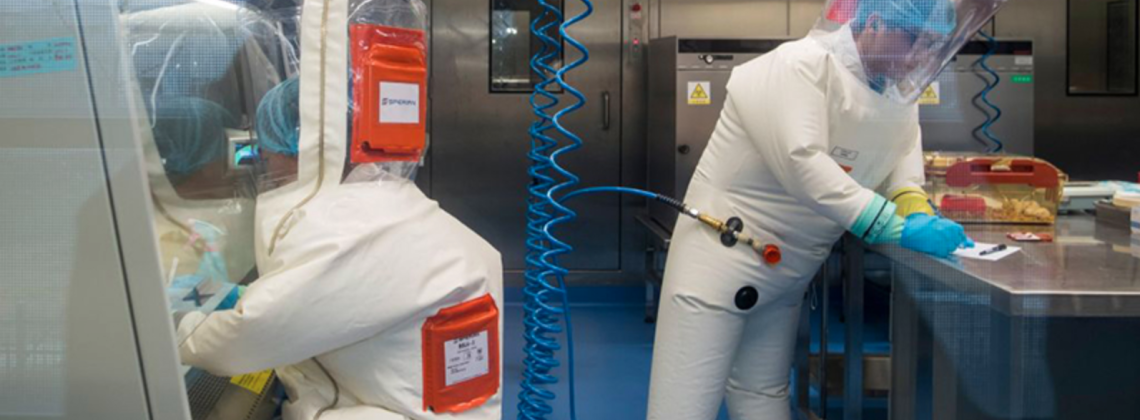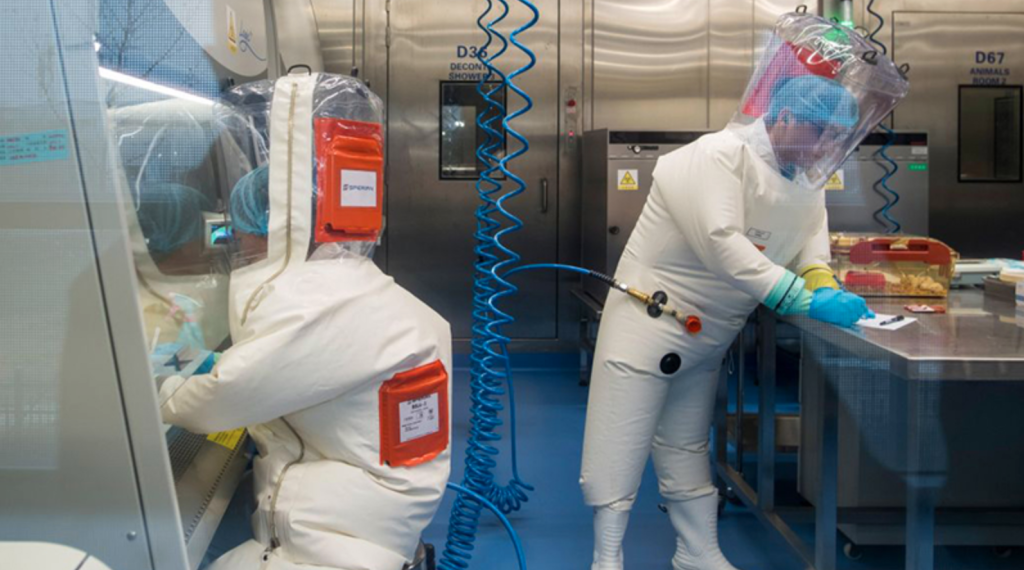

It’s right out of the totalitarian playbook: Deny, suppress, erase
Note: This essay was revised on 04/03/2023. A previous version incorrectly stated that Francis Gary Powers was flying low to the ground when his plane was shot down. I would like to thank Francis Gary Powers Jr. for pointing me to the declassified 1998 CIA documents that show that Powers was flying at the prescribed altitude and was not at fault for the crash.
Since the earliest days of SARS-CoV-2 a question has periodically popped up: What if this virus is not from the wild but is man-made? Or, as a modified combination theory suggests, what if the virus originated in the wild but jumped to human hosts via a lab leak? Recently the FBI released its conclusion that a lab leak may have been involved after all.
I am a doctor, but not that kind of doctor. I have zero qualifications to verify or deny this. I am, however, a historian. It is in this capacity that I propose to tell you a story that shows how a repressive totalitarian regime might never admit to this category of mistake.
The story begins in 1958, when the Mossad, Israel’s secret service agency, passed along disconcerting news to the CIA: It had learned of the existence of a top-secret biological weapons facility in Sverdlovsk (now Yekaterinburg), Russia. This was during the Cold War, and concerns over the existence of such a facility seemed merited. Could the USSR be developing bio-weapons?
The CIA’s solution was right out of a movie: Keep doing periodic fly-overs to see what is going on below. What could possibly go wrong? As it happens, one such fly-over, by an American U-2 spy plane on May 1, 1960, did go terribly wrong, resulting in an international incident and utter embarrassment for President Eisenhower, then in his final months in office. That embarrassment may also have influenced the presidential election a few months later, in which John F. Kennedy narrowly defeated Richard Nixon, Eisenhower’s vice president.
The plane in question was shot down as it was flying over Sverdlovsk. Its pilot, Francis Gary Powers, was captured. Like all proper spies, he was under strict orders to commit suicide by swallowing a cyanide capsule in case of capture. Unlike proper spies, he did not follow through.
Instead, the unlucky spy was interrogated and sentenced to three years in prison and seven years of hard labor. Luckily for him, he was traded back to the U.S. in 1962 in exchange for a Soviet spy. This was probably the best possible outcome for Powers, considering the rumored numbers of American soldiers and travelers who had been arrested on charges of spying and disappeared into the vast Gulag system in the preceding decade and a half, never to be seen again.
Whether because of this embarrassing incident or because of real data, by the end of the 1960s the CIA concluded that the Soviet Union was unlikely to use biological weapons in war, or at least unlikely to use them anytime soon. Not everyone agrees with that assessment, but the one thing modern researchers can agree on is that the Mossad’s information was correct. The Soviet research military lab located in Sverdlovsk was indeed researching and developing a number of biological weapons, including the Bubonic plague and anthrax.
I know a little bit about this because this was the facility at which my paternal grandparents worked during their time in Sverdlovsk in the 1960s. Like all researchers, they likely only knew the particular piece of the puzzle their work was designed to help complete. They were probably not aware of the overall goals of the program. But the work was undoubtedly dangerous.
A curious incident prompted them to leave Sverdlovsk in the mid-1960s. The reason for their abrupt departure sounds utterly wild, but it also reminds us of the danger of blowback inherent in biological warfare. A mysterious and deadly ailment began infecting residents in one neighborhood of the city. The residents were terrified and a medical emergency was declared. The disease puzzled doctors, who had not seen its like in their lifetime and were unable to diagnose it. Eventually the truth came out: A lab technician had accidentally cut himself in the lab and become infected. Since the cut was small, he had hoped to hide it and did not tell anyone. By the time he became symptomatic he had infected others. The military ultimately figured out what was going on and distributed a vaccine to the city’s residents, concluding the emergency that had forced parts of the city into quarantine.
As we have seen with the COVID-19 pandemic, all it takes to spread a virus is one single patient zero. Afterwards, contagious diseases can spread like wildfire, especially in a large city. And just as we saw in the early days of Covid, suppression of information in a time of crisis, while helping save face, only costs more lives. The instinct for the injured lab technician not to tell anyone about his injury was a quintessential Soviet reaction: Everyone was conditioned to keep any potentially embarrassing or dangerous details to themselves. But there is always a human cost to such secrecy.
In researching American sources about Sverdlovsk in the 1960s, I find repeated references to the existence of this bio-weapons research lab that so worried the Mossad and the CIA. But there is no mention of this particular lab leak. While the silence can make us wonder if it even happened at all, the absence of any mention that would back up the story my grandmother told my cousin decades later means nothing. Most likely, the incident happened but was covered up. How? Yet another incident—one that did manage to make international news, but just barely—is instructive.
In April 1979 this same Sverdlovsk facility was the location of what has been described as “the worst accident in the history of biological weapons production.” Two workers accidentally released several pounds of anthrax powder into the exhaust system of the facility, sending the highly toxic but colorless and odorless substance to waft and settle over the surrounding region of the city and some nearby villages to the south.
At least ninety-four people got sick and sixty-six died, but the exact death toll is impossible to know, since the Soviet Union denied the incident altogether, blaming the deaths instead on food poisoning from contaminated meat. The only reason this cover-up eventually leaked out was because some witnesses from the area escaped to the West. Much later, in 1996, sample tissue from the autopsies of the original victims would confirm anthrax deaths. But in the 1980s the incident had received worldwide newspaper coverage, unlike the accidental viral lab leak from the 1960s, which was successfully suppressed.
The existence of this second incident is suggestive for confirming the one through which my grandparents lived. It highlights a consistent attitude among the Soviet leaders at all levels: The same people who had no qualms arresting millions of innocent citizens and sending them to the Gulags also had no concern over the lives of citizens lost in other incidents that were, ultimately, the fault of the leaders who encouraged such reckless experimenting. All that mattered was keeping a good face for the West.
And so, as I consider the theories about the possible lab leak in Wuhan, and the adamant denial of any accident from the Chinese authorities, I am reminded again of the playbook of totalitarian regimes. When it comes to anything embarrassing, the motto is: Deny, suppress, erase.
Nadya Williams is Professor of Ancient History at the University of West Georgia. She is a monthly contributor to the Anxious Bench, and her essays have also appeared in Plough, Front Porch Republic, and Church Life Journal. Her book, Cultural Christians in the Early Church, is forthcoming in October 2023 from Zondervan Academic. She is the Book Review Editor for Current.
Not just the playbook of totalitarian regimes. Recall also that Eisenhower claimed the U-2 was a weather monitoring craft gone astray. NASA even cooked up a phony transcript of communications with the pilot claiming he was losing consciousness, and they painted a U-2 with NASA insignia to prove that they were using such planes for these missions.
This may have been the first case of a president blatantly and elaborately lying to/deceiving the American people (as opposed to exaggerating, spinning, omitting information, etc.)
True, John because the suppositions was that Powers was dead…until the Soviets revealed him to the world. I find suppression a constant on Fox News with any news that would discredit MAGA. It’s like Soviet television must have been.